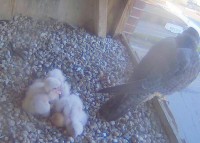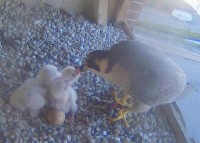Lawrence Peregrines: wing & leg stretching
May 21, 2018 in In the Nest Box, lawrence peregrines, Peregrine Falcons Eastern Massachusetts, Peregrine Falcons Massachusetts
Monday morning starts off under clear skies, bright sun, calm wind, and 52F. A beautiful day ahead with forecast that calls for sunny skies, with a high near 80. Calm wind becoming west 5 to 7 mph in the afternoon.
 Just before 6 AM, the female was seen brooding the 3 chicks and still keeping the addled egg close by. A number of the chicks were seen peeping out from under Mom’s protective cover. She rose up and walked to the edge of the nest box, rested for a time looking westward, and then departed in flight. She is starting to spend more time at edge of nest box and not brooding the chicks. As usual she returned moments later with prey in talons. Again, the prey had already been caught and was fully prepared for feeding the little ones. They continue to grow in size and appetite.
Just before 6 AM, the female was seen brooding the 3 chicks and still keeping the addled egg close by. A number of the chicks were seen peeping out from under Mom’s protective cover. She rose up and walked to the edge of the nest box, rested for a time looking westward, and then departed in flight. She is starting to spend more time at edge of nest box and not brooding the chicks. As usual she returned moments later with prey in talons. Again, the prey had already been caught and was fully prepared for feeding the little ones. They continue to grow in size and appetite.
 Day 8: The prey is often plucked and usually headless when received by the female, the head presumably being eaten by the male, and sometimes the neck as well. If more work is required in plucking and preparing the carcass, the female usually flies with it to an adjoining perch before starting this. The female at the nest box pins the prey firmly with its powerful feet and soon rips it up, giving the young tiny pieces when they are small, but larger portions as they develop.
Day 8: The prey is often plucked and usually headless when received by the female, the head presumably being eaten by the male, and sometimes the neck as well. If more work is required in plucking and preparing the carcass, the female usually flies with it to an adjoining perch before starting this. The female at the nest box pins the prey firmly with its powerful feet and soon rips it up, giving the young tiny pieces when they are small, but larger portions as they develop.
Falcon researcher, R. Wayne Nelson, noted in his peregrine falcon research, that preening, scratching, wing/leg stretching and wing fanning movements by the young began at about 8 days, and also the first signs of actions which become marked later, such as ruffling out of feathers and shaking of the body. Locomotion is still extremely limited at this age and confined to an ineffective shuffling motion of the tarsi. Sight is good enough to allow accurate pecking at any nearby objects. While young peregrines have a marked instinct to eject excrement out of the nest box, their power of defecation is slight at first but increases steadily.
Literature cited:
Ratcliffe, D. 1993. The Peregrine Falcon. 2nd ed. Carlton, England: T. and A. D. Poyser.
